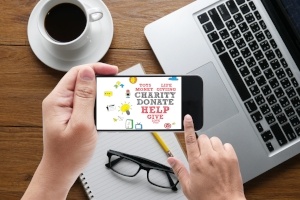Should Your Nonprofit Consider Implementing BYOD?

With technology in our pockets more powerful than that which landed humans on the moon, it’s no surprise we’ve gotten reliant on them for everything. The apps on our mobile devices allows us to handle our banking and investments, control our homes, and communicate face-to-face with people all over the world. Desktop computers aren’t mobile and even laptops sometimes can’t provide the mobility and ease of our smartphones and tablets. This is one reason why more and more institutions are implementing BYOD (Bring Your Own Device). Should your nonprofit look at implementing BYOD? Most likely, yes, but in a way that beneficial to all, not just your employees.
Why BYOD Works in Non-profits
Technology is expensive
From purchasing to upkeep it can have an affect on the bottom line and in non-profits that bottom line is sacred. As of November 2015 about 68% of American adults have a smartphone (an increase of 33% in four years).[i] This number is increasing exponentially and many middle-class Americans have multiple devices. It is likely that most, if not all of your staff in your nonprofit owns a personal mobile device and utilizes it for both personal and work tasks.
The reduction of expense is a great motivator for some to consider BYOD but there are other, more subtle advantages.
Go With What They Know
Some people like PCs. Others are fans of Mac. This argument has peppered modernity since the late 80’s and has carried over to smartphone and tablet loyalties. iOS? Android? BYOD allows employees to use what they’re already comfortable with, which means no learning a new interface. This makes for a quick transition with no time lost to learning a new system or waiting for matching devices to come in.
Considerations when Implementing BYOD
While the cost savings are obviously a huge benefit, as well as the more hidden pros like no haggling over which system or devices, and the fact that no time is lost training staff on a new interface, there are some things that must be considered when implementing this solution– and that must be thought of before implementing it.
Security First
The biggest obstacle to implementing BYOD is security.
Protecting Personal Information
From donor payment info to medical information, your databases are rich with the type of data you don’t want outsiders to access. As wonderful as BYOD can be, it takes away many of the built-in safeguards of traditional computing structures in non-profits. Having this data on personal devices opens you up to substantial risk. There are ways to combat that, all of which should be put into your BYOD policy.
Training
Before BYOD is implemented all members of your team should be trained in how, where, and why to use personal devices. After all, in addition to your non-profit’s information being taken out of the office your staff are also bringing their personal information onto your network. There needs to be a clear understanding of what and who can access what. IT needs must be assessed. While BYOD is great for those using it, it can be a nightmare for IT professionals used to one operating system and a traditional IT structure may not make sense any longer. A solution for this, which includes cost-saving measures, is moving to managed IT services. Needs are met by professionals dedicated to only handling IT with expertise in a variety of device specialties.
Buy In
BYOD is one of the few times in running a non-profit when employee buy-in will be one of your biggest foci. While you can create policies about dress code to enforce, and about hours and breaks and sick days, nothing is quite as tricky as developing comfort around a BYOD policy done right. That’s because you are melding personal property and your organization’s data — blurring the lines between work and the personal.
A good BYOD policy will face pushback, or at least questions, because it must contain safety measures for devices that are lost or stolen. Most nonprofits look at developing policies that allow them access to wipe at least some of the data on a lost device remotely so that information is no longer accessible. Staff will likely be concerned, as they should be, about what this means as far as their job’s reach into their personal data.
When building a policy, work with experts to create a one that is clear and fair. Be sure to work slowly, from the top down, to get buy-in and develop a plan that is secure but also fair when it comes to all stakeholders’ information.
BYOD is a cost effective, efficient addition to the non-profit industry, but must be approached carefully with clear attention to detail in order to protect the interests of all involved and the precious data with which you’ve been entrusted.
Still not convinced BYOD is right for your nonprofit organization? Check out of other blog post on BYOD: Is It Time to BYOD? and Pros, Cons and Solutions to Maximize BYOD. Both of these post going into more details on the BYOD, how it can help your organization and what aspect to consider before making the move. We also have a Free White Paper: How to Make the Best of BYOD that can provide even more insight onto this innovative trend.
{{cta(‘ba2078d2-bfdc-4d4f-a707-e5519d5931c6’)}}
[i] http://www.pcworld.com/article/2999631/phones/pew-survey-shows-68-percent-of-americans-now-own-a-smartphone.html
